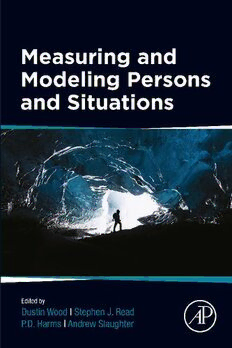Table Of ContentMeasuring and Modeling Persons
and Situations
Measuring
and Modeling Persons
and Situations
Edited by
Dustin Wood | Stephen J. Read
P.D. Harms | Andrew Slaughter
AcademicPress
125LondonWall,LondonEC2Y5AS,UnitedKingdom
525BStreet,Suite1650,SanDiego,CA92101,UnitedStates
50HampshireStreet,5thFloor,Cambridge,MA02139,UnitedStates
TheBoulevard,LangfordLane,Kidlington,OxfordOX51GB,UnitedKingdom
Copyright©2021ElsevierInc.Allrightsreserved.
Nopartofthispublicationmaybereproducedortransmittedinanyformorbyanymeans,
electronicormechanical,includingphotocopying,recording,oranyinformationstorageand
retrievalsystem,withoutpermissioninwritingfromthepublisher.Detailsonhowtoseek
permission,furtherinformationaboutthePublisher’spermissionspoliciesandourarrangements
withorganizationssuchastheCopyrightClearanceCenterandtheCopyrightLicensingAgency,can
befoundatourwebsite:www.elsevier.com/permissions.
Thisbookandtheindividualcontributionscontainedinitareprotectedundercopyrightbythe
Publisher(otherthanasmaybenotedherein).
Notices
Knowledgeandbestpracticeinthisfieldareconstantlychanging.Asnewresearchandexperience
broadenourunderstanding,changesinresearchmethods,professionalpractices,ormedical
treatmentmaybecomenecessary.
Practitionersandresearchersmustalwaysrelyontheirownexperienceandknowledgeinevaluating
andusinganyinformation,methods,compounds,orexperimentsdescribedherein.Inusingsuch
informationormethodstheyshouldbemindfuloftheirownsafetyandthesafetyofothers,
includingpartiesforwhomtheyhaveaprofessionalresponsibility.
Tothefullestextentofthelaw,neitherthePublishernortheauthors,contributors,oreditors,
assumeanyliabilityforanyinjuryand/ordamagetopersonsorpropertyasamatterofproducts
liability,negligenceorotherwise,orfromanyuseoroperationofanymethods,products,
instructions,orideascontainedinthematerialherein.
LibraryofCongressCataloging-in-PublicationData
AcatalogrecordforthisbookisavailablefromtheLibraryofCongress
BritishLibraryCataloguing-in-PublicationData
AcataloguerecordforthisbookisavailablefromtheBritishLibrary
ISBN:978-0-12-819200-9
ForinformationonallAcademicPresspublications
visitourwebsiteathttps://www.elsevier.com/books-and-journals
Publisher:NikkiLevy
AcquisitionsEditor:JoslynChaiprasert-Paguio
EditorialProjectManager:BarbaraMakinster
ProductionProjectManager:KiruthikaGovindaraju
CoverDesigner:ChristianJ.Bilbow
TypesetbySPiGlobal,India
Contents
Contributors xvii
1. A role for information theory in personality
modeling, assessment, and judgment
DavidM.Condonand Rene(cid:1) Mo˜ttus
BackgroundonShannon’sinformationtheory 2
Analogapplications 5
Digitalapplications 8
Invokinginformation-theoreticapproachesinpersonality
assessment 17
Emphasizingtheneedsofresearchersovertestadministrators 17
Nextsteps 20
Towardsadigitalrepresentationoftheanalogexperience 23
References 24
2. What falls outside of the Big Five? Darkness,
derailers, and beyond
P.D.Harms andRyneA. Sherman
Darkpersonality 34
DarkTriad 35
Hoganpersonalityderailers 38
Alternativemodelsofdarktraits 40
Mappingthepsychologicaldriversofdarktraits 42
Predictionofworkoutcomes 43
Positiveeffectsofdarktraits 44
Nonlinearrelationships 45
Moderatorsofdarkpersonality 46
Gender 46
Ageandtime 47
Cultureandcontext 48
Darkpersonalityassessmentissues 48
Self-awarenessandhonestreporting 48
Specificityofmeasures 49
Highlyabbreviatedmeasures 50
Five-factorbasedmodels 51
Emergingtrendsinassessment 52
v
vi Contents
Futuredirectionsandconcludingthoughts 54
References 57
3. Semantic and ontological structures of psychological
attributes
JanKetil ArnulfandKaiRune Larsen
Introduction 69
Likeallotherpeople:Languageisastrongsituation 71
Digitaltextanalysis 75
Background 75
ApracticalguidetoconductingLSA 77
ComparingtextstoLikertscaledata 78
Thesemantictrapcalledthejingle-janglefallacy 80
Semanticoverlapinresearch:Howmostpeoplewillreact 81
Wheresemanticsfailed:Thecaseofpersonalitytesting 85
Likenootherpeople:IndividualdifferencesinSTSR 87
Likesomeotherpeople:Group-leveldifferencesidentifiedin
STSR 90
Conclusion:Applicationsanddevelopmentsinsemantics 93
References 95
4. Ubiquitous computing for person-environment
research: Opportunities, considerations,
and future directions
Sumer S.Vaid,SaeedAbdullah,Edison Thomaz,and
GabriellaM. Harari
Assessingbehaviors,persons,andenvironmentswithubicomp
devices 104
Measuringandmodelingbehaviors 106
Measuringandmodelingpersons 118
Measuringandmodelingenvironments 123
Outlook 125
Practicalconsiderations 126
Ethicalconsiderations 131
Futuredirections 132
Conclusion 134
References 135
5. Modeling the mind: Assessment of if … then …
profiles as a window to shared psychological
processes and individual differences
VivianZayas,Randy T.Lee,and YuichiShoda
Introduction 145
Mentalinferenceindailylife:Ananecdotalillustration 147
Cognitive-AffectiveProcessingSystemtheory:Basicprinciples 148
Contents vii
TheCAPSnetwork 148
Originalconceptualizationandmeasurementofif…then…
profiles 151
Acontemporaryapproachtoconceptualizingif…then…profiles:
TheHighly-RepeatedWithin-Person(HRWP)approach 153
TheHRWPapproach:Assessingfeaturespresentinasituation 154
AprimertotheHRWPapproach 157
Data-driven,“bottom-up”approach 159
Theory-driven,“top-down”approach 160
Howdoesstudyingif…then…profilesshedlightonthe
personalitysystem? 160
IllustratingtheHRWP“top-down”approach:Reanalysisofa
transferencestudy 162
Studyingtransference 163
TheHRWPapproachtostudyingtransference 165
ReanalysisofthetransferencestudyusingtheHRWP
approach 166
Exploringunexplainedvariability:Identifyingsystematic
variability 173
ImplicationsofusingtheHRWPapproach 177
Amoredirectapproachofassessingintraindividualpsychological
processesbymeasuringintraindividualdynamics 178
Bolsteringcausalinferenceandassessingtheheterogeneity(vs
homogeneity)ofeffects 179
Aunifiedframeworkforassessingsharedpsychologicalprocesses
andindividualdifferences 180
Whatdoif…then…profilesrevealaboutaperson? 180
Whatisanif?Lookingforward 181
ApplicationsoftheHRWPapproach 182
Concludingremarks 183
Appendix 183
RCode 183
References 184
6. Psychological targeting in the age of Big Data
Ruth E.Appel andSandra C.Matz
Introduction 193
Psychologicaltargeting:Atwo-stageframework 194
Driversofpsychologicaltargeting:BigDataandMachine
Learning 196
Newand“bigger”data 196
Newanalyticaltechniques 197
Thescienceofpsychologicaltargeting 199
Stage1:Psychologicalprofiling 199
Psychologically-informedinterventions 202
Researchopportunities 203
Researchchallenges 206
viii Contents
Practicaladvice 208
Ethicalconsiderations 209
Ethicalopportunities 210
Ethicalchallenges 211
Suggestionsforaddressingtheethicalchallenges 214
Conclusion 216
References 217
7. Virtual environments for the representative
assessment of personality: VE-RAP
LynnCarol Miller, David C.Jeong,and
JohnL.Christensen
Whatisavirtualrepresentativedigitalenvironment:
Relevance? 224
Commercialvirtualenvironmentsandpersonalitycorrelates 224
Whatarewetryingtoassessdynamicallyinvirtual
environments? 225
Virtualenvironmentaffordancestoleverageforpersonality
assessment 228
Virtualrepresentativeenvironmentsforcorrelationaland
experimentalstudies 235
Generalizabilitytoeverydaylife 235
Challengesabound:Whyrepresentativevirtual
environments? 236
Shiftinggranularityandtimescale:Challenges 236
Measuringthe“unit”(cid:1)situationdynamics 237
Virtualenvironmentsforrepresentativeassessments:How? 238
Overviewofformativeresearchneeded 238
Targetaudience 239
BehavioralandscriptoptionsforthePOI:Formativeresearch
needed 240
Personalityconceptualization 240
Representativelocations 241
Affordances 242
Measuringgoal-affordancedynamics 242
Scripts,situational-GPRB,andbehavioraloptions 242
Interoceptivestatesandaffect 243
UltimateBOI 244
Discussion 245
Conclusionsandfuturedirections 245
References 246
8. Improving measurement of individual differences
using social networks
AndrewSlaughter andJanie Yu
Introduction 253
Analyzingsocialstructure 254
Descriptivestatisticsforsocialstructure 255
Contents ix
IntegratingmodelsforSNAandIRT 261
Itemresponsetheorymodelsforindividualdifferences 261
Measurementmodelsforindependentdyadsandegocentric
networks 264
IRT-ERGM:Integratingmodelsforindividualmeasurementand
networkstructure 268
Exampleanalysis 275
Discussion 279
References 281
9. Situational judgment tests: From low-fidelity
simulations to alternative measures of personality
and the person-situation interplay
FilipLievens, Philipp Scha€pers,andChristophN. Herde
Introduction 285
SJTs:Definitionandbriefhistory 287
Definition 287
Briefhistory 289
Thetraditionalview:SJTsaslow-fidelitysimulations 289
Underlyingtheoryandrationale 289
SJTdevelopment 290
Construct-relatedvalidityevidence 291
Criterion-relatedvalidityevidence 292
SJTsinthetrainingcontext 292
SJTsasalternativemeasuresofpersonality 293
Characteristicsanddevelopment 293
Underlyingtheory 295
Construct-relatedandcriterion-relatedvalidityevidence 296
SJTsandthepersonality-situationinterplay 298
Assessmentofsituationconstrual 298
Assessmentofwithin-personvariabilityacrosssituations 299
Assessmentofsituation-traitcontingencies 300
Assessmentofproactivetransactions 301
Assessmentofbehavioralresponses 302
Assessmentofnarrativesandgoals 302
Assessmentofpersonalitydisorders 303
Epilogue 303
References 304
10. Intra-individual variability in personality:
A methodological review
AlishaM. Ness,Kira O. Foley, andEricHeggestad
Introduction 313
FoundationalissuesandapproachesunderlyingIIVP 314
KeycontemporarytheoreticalperspectivesonIIVP 318
Examiningthecurrentstateoftheliteratureandfuture
recommendations 323

